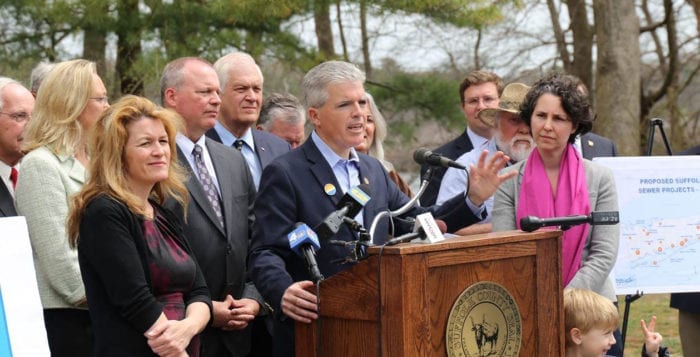Suffolk lawmakers have taken the first step toward preservation of nearly 41 acres in St. James as open space.
The county legislature voted at its Nov. 21 meeting to approve a bill introduced by Legislators Kara Hahn (D-Setauket) and Rob Trotta (R-Fort Salonga) for an appraisal of part of the Gyrodyne LLC property in St. James, also known as Flowerfield, that runs along Route 25A. The property contains freshwater wetlands and adjacent wetlands that feed into the Long Island Sound, Mill Pond in Stony Brook and Stony Brook Harbor.
“I am greatly appreciative of my legislative colleagues’ support for our effort to preserve 41 undeveloped acres of the former Gyrodyne property,” Hahn said. “With the owner actively seeking to develop the property, this perhaps is the community’s last stand to preserve one of the last large undeveloped tracts remaining in western Suffolk County. I am hopeful that the owner will understand the property’s overall environmental significance and its potential to negatively impact surrounding ground and surface waters, traffic safety and overall quality of life should it be developed.”
The bill, which now goes to Suffolk County Executive Steve Bellone (D) for his approval, allows for the county’s planning division to assess the owner’s interest in selling the tract to the county for open space purposes. An interest by Gyrodyne would mean the county could follow its initial outreach by obtaining a real estate appraisal and additional legal and environmental reviews that are required for a potential sale from the company to the county. According to county law, if sale of the land parcel can be negotiated, funding will come from the county’s Drinking Water Protection Program.
“With the owner actively seeking to develop the property, this perhaps is the community’s last stand to preserve one of the last large undeveloped tracts remaining in western Suffolk County.”
— Kara Hahn
While preservation of the land is being considered, a conceptual development plan from Gyrodyne was approved by the Suffolk County Planning Committee Aug. 2 and was met with resistance from Stony Brook and St. James residents.
Over the summer, the property’s owner submitted an application to the Town of Smithtown to construct a 150-room hotel with restaurant and day spa, two medical office buildings totaling 128,400 feet and two long-term care buildings that would have a total 220 assisted living units on the property. Many in the area raised concerns about the amount of traffic that would empty out onto Route 25A and Stony Brook Road if an exit to the Brookhaven street was made accessible on the east side.
Trotta said he’s not completely against development as he realizes the community needs businesses such as the proposed assisted living facility. However, Trotta said he understands the community’s concerns about traffic and would like to see a good amount of the property preserved.
“It’s always about balance,” he said.
Trotta said he believes Gyrodyne will be willing to work with the community.
“I don’t think it’s unreasonable to have it appraised and get into discussions with what the community wants, what can we put up with traffic-wise and meet somewhere in the middle,” Trotta said.
At a Nov. 15 Smithtown Planning Board meeting, Gyrodyne representatives said their own traffic studies proved residents had sound reason to be concerned about increased traffic and pointed to six local intersections that needed improvement. The results were submitted to the Town of Smithtown and New York State Department of Transportation in October 2017 but have yet to be reviewed. Conrad Chayes Sr., chairman of the Smithtown Planning Board, concluded the board would hold off on a decision until an environmental impact study is completed by the town, which he said may take up to a year.
Hahn said the commercial development of the land would “fundamentally change the character of the Stony Brook and St. James communities.”
“Each of us, regardless of which side of the Brookhaven-Smithtown border you reside on, is threatened by this project moving forward,” Hahn said. “For that reason, Legislator Robert Trotta and I put forward legislation to preserve these environmentally and historically important parcels from being destroyed.”













